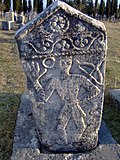| Klobuk fortress | |
|---|---|
Old town Klobuk | |
| Klobuk, Trebinje | |
 Klobuk Fortress, southern stronghold of Pavlović family, later captured by Stjepan Vukčić Kosača | |
| Site information | |
| Type | Castle (residential, fortification) |
| Owner | Pavlović noble family |
| Controlled by |
|
| Open to the public | yes |
| Condition | ruined |
| Location | |
| Coordinates | 42°42′17″N18°32′49″E / 42.70465°N 18.54705°E |
| Site history | |
| Built | before 10th c. |
| Built by | multilayered (probably of local Illyrian) |
| Materials | Limestone (partly ashlar) |
| Designations | (Protected as National Monument of Bosnia and Herzegovina) |
| Site is protected as National Monument of Bosnia and Herzegovina by The Government of Bosnia and Herzegovina and its KONS BiH [1] | |

Klobuk is a medieval fortress in Bosnia and Herzegovina. It is located on the karst plateau of Mirotinske grede, near the village of Klobuk, Trebinje, in the Republic of Srpska entity of Bosnia and Herzegovina. It is declared a National Monument of Bosnia and Herzegovina, by the Commission to Preserve National Monuments of Bosnia and Herzegovina.


